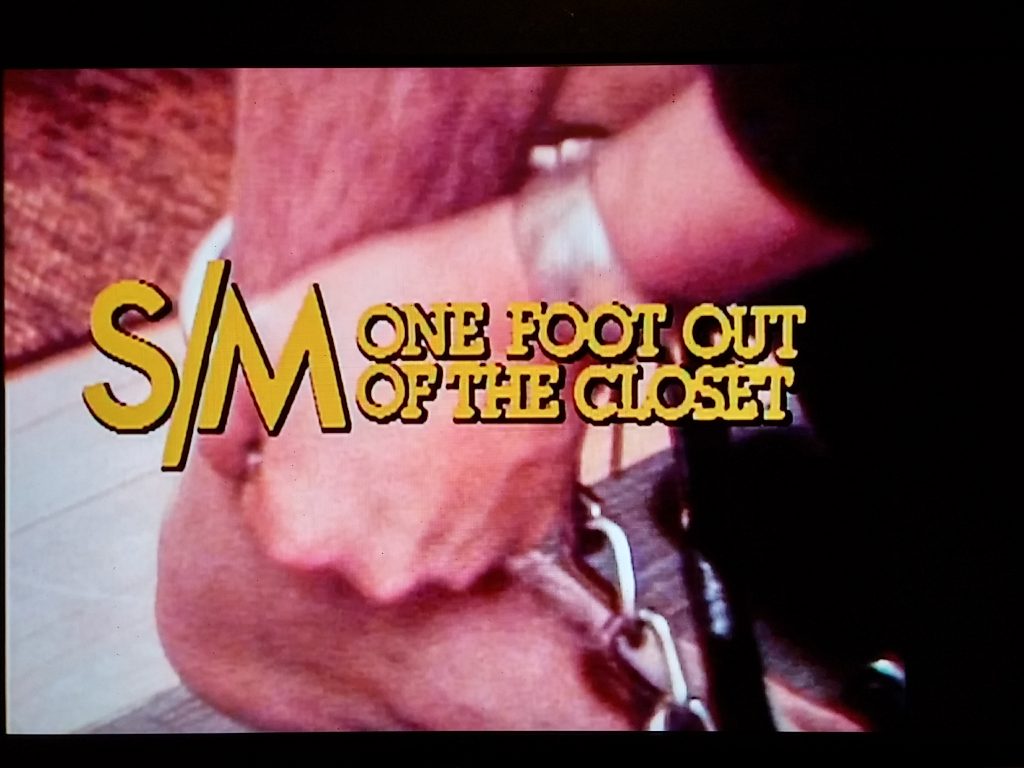For a while, I’ve seen references to a 1980 documentary about kinky people, aired on public television station KQED. Online searches turned up nothing, but I finally put in the effort to look up KQED and see if I could somehow get access to it, if only partially. After a few emails, they were kind enough to give me access to a stream of the 36-year-old documentary. I had to sign a fairly restrictive agreement, so I can’t share any of it.
Elliot and Ahsley continue their relationship, now into vanilla sex. This scene is fully in the conventions of softcore porn, with soft lighting and rich textiles in Elliot’s bedroom, instead of the hard lighting and concrete walls of his dungeon. He even makes her breakfast the next morning. While it’s competently done, it’s pretty standard, instead of the kink we were promised. I have nothing against romance, but you can get that everywhere.
Episode 3
This episode starts off with another soft-core BDSM scene in Nolan’s dungeon. It’s competently shot, with implied cunnilingus and male butt exposure, but doesn’t go into the characters at all, except for hinting that Dylan is getting jealous of the women she brings to him.
Most of this episode revolves around a party. Borrowing Linda Williams’ observation in Hard Core that sex serves the function in porn that singing and dancing does in musicals, this provides a premise for various subplots and couplings. Such as Elliot getting Ashley in his sights. She fascinates him more than Dylan’s latest acquisition for him, who promises “nothing is off limit”.
- A Brief History of the Dominatrix, not terribly deep.
- Dominatrix imagery in fashion photography, also not terribly deep.
- Ever wonder what happened to the Vault, the Mineshaft and other BDSM bars and clubs? Now they’re restaurants you probably can’t afford to eat at.
- An in-depth essay on Leopold von Sacher-Masoch and Venus in Furs.
- The Political Uses of Lesbian Romance Fiction: Reading Patrick Califia’s Macho Sluts as a Response to 1980s Anti-Pornography Feminism
- History of leather women’s groups in San Francisco
- An essay on Wonder Woman creator and bondage fan William Moulton Marston
- Bet you didn’t know that in 1972, Bernie Sanders wrote an essay about men and women having sadomasochistic fantasies.
Lying somewhere on the boundary between affectionate fetishism and domestic violence, spankings between lovers or would-be lovers were a staple of Hollywood romance movies. Jezebel has a pictorial and essay on the subject, by Andrew Heisel. This was reflected in real-life practices of the time, when husbands were expected to treat their lives like children.
According to the New Yorker, the Van Dykes were a microculture of nomadic lesbian separatists who roved around the US in vans (hence the collective and individual names) in the late 1970s. They were on a quest of sorts to explore the new frontier of lesbian culture. Interestingly, when the mainstream of lesbian feminists were building an orthodoxy position that female sexuality was inherently domestic, monogamous, and without power dynamics, the Van Dykes went in the opposite direction, developing a new sexual culture of what would today be called polyamory and sadomasochism.
During yet another fight among the Van Dykes over who was sleeping with whom, Heather recalls, Judith left in a huff and caught a ride to San Francisco. There she met the sex radicals Pat Califia and Gayle Rubin, who had started a lesbian sadomasochist group that they called Samois, for the house of torture in “The Story of O.” “She hooked up with those women and when she came back she said, ‘You’re going to love this,’ “ Van Dyke remembers. Judith was not mistaken: tofu quickly gave way to leather in the vans. The Van Dykes loved the drama of sadomasochism, the way it gave them license to play power games—which, really, they had been engaged in all along. For Heather Van Dyke, who had been a kind of lesbian Joseph Smith, driving around the continent looking for the promised land with a band of wives and ex-wives and future wives in tow, the idea of being explicitly dominant—a top, in the parlance of sadomasochism—was particularly appealing.
[…]
Lesbianism in the seventies had been configured as a loving sisterhood in which sex was less important than consciousness-raising. For many gay women, sadomasochism was an antidote to this tepid formulation. It was permission to focus on what turned them on, rather than what was politically correct, a way of appropriating the lust and power hunger that feminist doctrine had deemed male. “We’d been being egalitarian,” Lamar Van Dyke told me. “And suddenly we were over it.”
The Van Dykes even gave a SM workshop at the 1979 Michigan Womyn’s Music Festival, which in later years would be the site of many conflicts over the presence and visibility of BDSM.
One way to view the Internet is as a vast sorting system, in which individuals can curate collections of material that might never be allowed to come together otherwise. I found the Fraulein Swastika Tumblr [removed as of 16 June 2021] recently, a collection of erotic images of women with fascist elements. What’s interesting is that the images seem to come from at least three different discourses.
Continue reading »
I suppose it was inevitable that, given the prominence of (a version of) BDSM after Fifty Shades and the creative opportunities of the golden age of cable TV, somebody would do a BDSM-themed TV series. To be honest, I went into Showtime’s Submission with low expectations.



